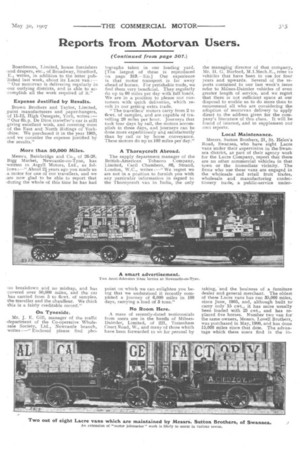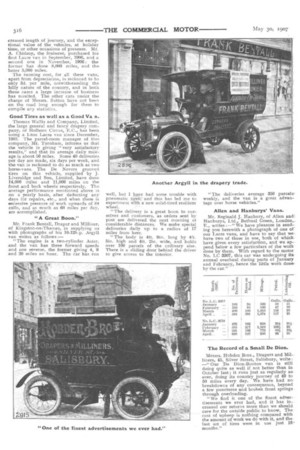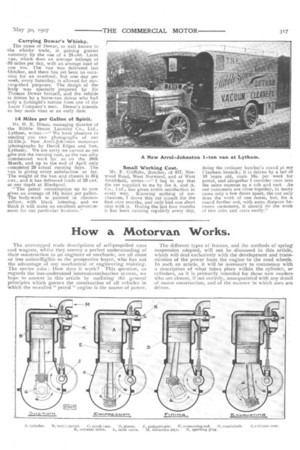Reports from Motorvan Users.
Page 3

Page 4

Page 5

If you've noticed an error in this article please click here to report it so we can fix it.
Boardmans, Limited, house furnishers and drapers, etc., of Broadway, Stratford, E,, writes, in addition to the letter pub. lished last week, about its Lacre van:— Our motorvan is delivering regularly in -our outlying districts, and is able to accomplish all the work required of it," Expense Justified by Results.
Brown Brothers and Taylor, Limited, .paint manufacturers and paper-hangers, of 11-12, High Ousegate, York, writes :— "Our 6h.p, De Dion traveller's car is still giving excellent work, and covering most of the East and North Ridings of Yorkshire. We purchased it in the year 1905, and we consider the expense justified by the results."
More than 50,000 Miles.
Messrs. Bainbridge and Co., of 26-28, Bigg Market, Newcastle-on-Tyne, has written to Argyll Motors, Ltd., as follows :---" About 24 years ago you made us .a motor for one of our travellers, and we are now glad to be able to report that ,during the whole of this time he has had -alo breakdown and no mishap, and has -covered over 50,000 miles, and the car has carried from 5 to 6ewt. of samples, -the traveller and the chauffeur. We think -this is a fairly creditable record."
On Tyneside.
Mr, J. E. Oill, manager of the traffic -department of the Co-operative Wholesale Society, Ltd., Newcastle branch, -writes :—" Enclosed please find pho• tographs taken in our loading yard. [The largest of these is reproduced on page 319.—ED.] Our experience is that motor transport is far away ahead of horses. For perishable trade, we find them very beneficial. They regularly do up to 60 miles per day with full loads. We are in a position to please our customers with quick deliveries, which result in our getting extra trade.
The travellers' motors carry from 2 to 6cwt. of samples, and are capable of travelling 20 miles per hour. Journeys that took four days by rail, the motors accomplish in three days, and journeys can be done more expeditiously and satisfactorily than by rail or by horse conveyance. These motors do up to 100 miles per day."
A Thornycroft Abroad.
The supply department manager of the British-American Tobacco Company, Limited, Cecil Chambers, 86, Strand, London, W.C,, writes :--" We regret we are not in a position to furnish you with any particular information in regard to the Thornycroft van in India, the only point on which we can enlighten you being that we understand it recently completed a journey of 6,000 miles in 108 days, carrying a load of 3 tons."
No Room Here.
A mass of recently-dated testimonials from users are in the hands of MilnesDaimler, Limited, of 221, Tottenham Court Road, W., and many of those which have been forwarded to us for perusal by
the managingdirector of that company, Mr. II, C. Burford, M.I.Mech.E., refer to vehicles that have been in use for four years and upwards. Several of the reports contained in our last week's issue refer to Milnes-Daimler vehicles of even greater length of service, and we regret that there is not sufficient space at our disposal to enable us to do more than to recommend all who are considering the adoption of motorvart delivery to apply direct to the address given for the company's literature of this class. It will be found of interest, and to supplement our own reports.
Local Maintenance.
Messrs. Sutton Brothers, 21, St. Helen's Road, Swansea, who have eight Lacre vans under their supervision in the Swansea district, as part of their agency work for the Lacre Company, report that there are no other commercial vehicles in that town or the immediate vicinity. The firms who use these vans are engaged in the wholesale and retail fruit trades, wholesale and manufacturing confectionery trade, a public-service under
taking, and the business of a furniture dealer and general merchant. The oldest of these Lacre vans has run 35,000 miles, since June, 1905, and, although built tocarry only 15 cwt., it has more usually been loaded with 25 cwt., and has replaced five horses. Number two van for the same owners, Messrs. Lovell Brothers, was purchased in May, 1906, and has done 15,000 miles since that date. The advantage which these users find is the in
creased length of journey, and the exceptional value of the vehicles, at holiday time, or other occasions of pressure. Mr. A. Chidzoy, the fruiterer, purchased his first Lacre van in September, 1906, and a second one in November, 1906: the former has done 8,000 miles, and the latter 5,000 miles.
The running cost, for all these vans, apart from depreciation, is reckoned to be, only 3d. per mile, notwithstanding the hilly nature of the country, and in both these cases a large increase of business has resulted. The other cars under the charge of Messrs. Sutton have not been on the road long enough for them to compile any statistics.
Good Tires as well as a Good Va. n.
Thomas Wallis and Company, Limited, the large general and fancy drapery company, of Holborn Circus, E.C., has been using a 1-ton Lacre van since December, 1905. The parcel-room manager of this company, Mr. Turnham, informs us that the vehicle is giving "very satisfactory results,' and that its average daily mileage is about 50 miles. Some 40 deliveries per day are made, six days per week, and the van is reckoned to do as much as two horse-vans. The Be Nevers grooved tires on this vehicle, supplied by J. Liversidge and Son, Limited, have done 14,000 miles and 11,000 miles on the front and back wheels respectively. The average performance mentioned above is on a yearly basis, after deducting any days for repairs, etc., and when there is excessive pressure of work upwards of 84 calls, and as much as 60 miles per day, are accomplished.
"A Great Boon."
Mr. Frank Bentall, Draper and Milliner, of Kingston-on.Tharnes, in supplying us with photographs of his 10-12h.p. Argyll van writes as follows :—
" The engine is a two-cylinder Aster, and the van has three forward speeds and one reverse, the former giving 4, 9 and 20 miles an hour. The car has run well, but I have had some trouble with pneumatic tires; and this has led me to experiment with a new solid-tired resilient wheel.
"The delivery is a great boon to ourselves and customers, as orders sent by post are delivered the next morning at considerable distances. We make special deliveries daily up to a radius of 17 miles from here.
"The body is 4ft. 9in, long by 4ft. Sin, high and 4ft. 2in. wide, and holds over 100 parcels of the crdinary size. There is a sliding door behind the driver to give access to the interior.
"The deliveries average 330 parcels.' weekly, and the van is a great advantage over horse vehicles."
Allen and Hanburys' Vans.
Mr. Reginald J. Hanbury, of Allen and Hanhurys, Ltd., Bethnal Green, London,. E., writes :—" We have pleasure in sending you herewith a photograph of one or our I.acre vans, and have to say that we have two of these in use, both of which. have given every satisfaction, and we append below a few particulars of the work done by them. With regard to the motor No LC 3307, this car was undergoing its. annual overhaul during parts of January and February, hence the little work done, by the car."
Messrs. Hobden Bros., Drapers and Mil. liners, 45, Silver Street, Salisbury, write: —" Our De Dion-Bouton van is still doing quite as well if not better than in October last ; it runs just as regularly asever, doing its country journey of 40 to 50 miles every day. We have had no breakdowns of any consequence, beyond a few punctures and broken front springs through overloading. "We find it one of the finest advertisements we ever had, and it has increased our returns more than we should care for the outside public to know. The cost of upkeep is nothing compared with the amount of work we do with it, and thelast set of tires were in use just 10, months."
Carrying Dewar's Whisky.
• The name of Dewar, so well known in :the whisky trade, is gaining greater notoriety by the use of a 24-cwt. Lacre van, which does an average mileage of :35 miles per day, with an average load of one ton. The van was delivered last October, and there has yet been no occasion for an overhaul, but one day per week, every Saturday, is allowed for running-shed purposes. The design of the body was specially prepared by Sir Thomas Dewar himself, and the vehicle is driven by a horse-van driver who had only a fortnight's tuition from one of the Lacre Company's men. Dewar's intends to buy more vans at an early date.
14 Miles per Gallon of Spirit. Mr. H. E. Dixon, managing director of he Ribble Steam Laundry Co., Ltd.,
Lytham, writes We have pleasure in sending you two photographs of our 12-15h.p. New Ancl-Jobnston inotorvan (photographs by David Edges and Son, Lytham). We are sorry we cannot as yet ,give you the running cost, as the van only -commenced work for us Ott the 28th March, and up to the end of April only ,completed 29 actual running days. The van is giving every satisfaction so far. The weight of the van and chassis is 37* -cwt., and it has delivered loads of 23 cwt, at our depot at Blackpool.
" The petrol consumption up to now gives an average of 144 miles per gallon. The body-work is painted in chromoyellow, with black lettering, and we think it will make an excellent advertisexi-lent for our particular business."
Small Working Cost.
Mr. F. Griffiths, Butcher, of 417, Norwood Road, West Norwood, and at West Smithfield, writes :—" I beg to say that the car supplied to me by the A. and A. Co., Ltd., has given entire satisfac.tion in every way. Knowing nothing of mechanism, I drove this car myself for the first nine months, and only had one short stop with it. During the last four months it has been running regularly every day,
doing the ordinary butcher's round at my Clapham branch; it is driven by a lad of 18 years old, costs 10s. per week for petrol, and altogether I consider runs into the same expense as a cob and cart. As our customers are close together, in many cases only a few doors apart, the car only does the work of one horse, but, for a round further out, with some distance between customers, it should do the work of two cobs and carts easily."


























